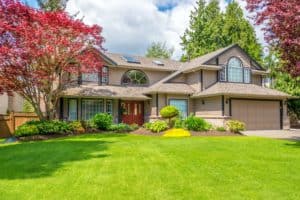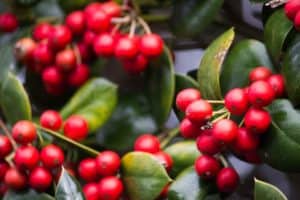Landscape Design Tips for Beginners
There are many details to consider when designing a landscape.
Following the pointers below could be the difference between a blah or beautiful landscape!
Depth:
If you have the space, make your landscape bed at least eight feet deep (distance from the house to the edge of the bed). This provides opportunities to have plants in the foreground, middle-ground and near the house which creates a more three-dimensional effect. Adding the depth to your landscaping is more attractive than one or two rows of plants lined up along the foundation of the house.
Larger beds can sometimes seem excessive to a homeowner. However, once the project is completed, they often wish they went even larger!
Elevation:
Add topsoil to elevate the landscape beds above the lawn. It is much more visually appealing to have the beds raised 6- 8 inches above the lawn than having the landscape beds at the same level as the lawn.
 Again, very often a homeowner doesn’t see the need for this detail. However, when it is done, they realize that it makes a big difference. Caution: don’t create a “moon-scape”! The soil should be level – avoid mounds and craters.
Again, very often a homeowner doesn’t see the need for this detail. However, when it is done, they realize that it makes a big difference. Caution: don’t create a “moon-scape”! The soil should be level – avoid mounds and craters.
Accent Your House:
Don’t let the landscaping overpower your house. Put taller plants (trees) at the corners and lower plants in front of the house.
Adding a small to medium sized tree, such as a Flowering Dogwood, Lace-Leaf Japanese Maple or Eastern Redbud in the lawn, between the street and house, adds another dimension. When someone views your house from the street, their eye will momentarily stop at this tree first before they look at the house. The person viewing your house won’t realize that their eye stopped for that fraction of a second but, they will view your landscaping more favorably.
Don’t Create Curves Without a Reason:
It is common to see a landscape with curves that make no sense. Curves can look very nice, but they look awkward if there is no reason for the curve. For example, if you want to put in a walkway from your sidewalk to your front door and you want a curve in the walkway, add a tree where the walkway curves. This way it will look like the curve was needed to go around the tree.
Seasonal Changes:
There is nothing more boring than a landscape that looks the same in July as it does in January. A well planned landscape will include some evergreen plants to provide foliage all year round, but it should also include flowering plants and perennials. Bulbs are also a nice addition to provide vibrant color in the spring. Ornamental grasses can add another element. If you don’t cut them back until spring, they look nice blowing in the wind and snow in the winter.
 Keep All Seasons in Mind:
Keep All Seasons in Mind:
In winter, it is nice to have trees with interesting bark. The bark can be an unusual texture or color. Also, shrubs like the deciduous Winterberry Holly provide bright red berries in the winter (remember, with a holly, you will need a male plant to get the berries on your female plants).
Lawn:
A beautiful house and landscape needs a beautiful lawn. A weedy, off-color or thin lawn takes away from an otherwise beautiful property. A lawn fertilization and weed control program is an inexpensive solution to complete your landscaping project. Your lawn care program should also provide services to protect your lawn from damaging insects such a grubs and chinch bugs.
Tree & Shrub Care:
The conditions where landscape plants grow in nature (forests, edges of woodland areas, etc.) are very different than the growing conditions in the suburban (or urban) landscape.
Think of the Dogwood and Redbud trees mentioned above. Both of these trees and under-story trees are in the forest. That means, they are shaded by the taller trees, they are surrounded by other trees which break strong winds and help support the tree. These trees are usually standing alone in a home landscape and often are exposed to more sunlight and heat than is good for the tree.
The forest also has completely different soil than what is found a cultivated landscape. Hundreds of years of leaf-litter have accumulated and decomposed in a forest. This soil is a vibrant, living environment. The soil in a residential landscape is not.
For example, there are beneficial bacteria’s that grow in the forest – but not the cultivated landscape. This bacteria (Mycorrhizae) grows into the roots of the plants and out into the soil adjacent to the roots. This connection provides a natural link between the plant’s roots and the soil which allows plants to more efficiently absorb nutrients and water better than they would on their own. Green Giant’s tree and shrub programs include Mycorrhizae with our root-zone fertilization service.
A good tree care program can help trees and shrubs overcome these less than desirable growing conditions.
Plants in the less-hospitable environment of a home landscape are also more likely to be attacked by damaging insects and diseases. A tree care program needs to be determined by the specific types of plants you have to ensure the needs of all plants are covered (and that unnecessary treatments are not performed).
Green Giant offers Tree Care applications to help keep your trees and shrubs healthy and beautiful.

Lawn Care
Green Giant Home & Commercial’s Lawn Care services control weeds, build the thickness and density of your lawn and protect it from being damaged by insects and disease, providing you with a great-looking, healthy lawn. We offer fertilization, weed control, liming, insect control, and aeration and overseeding. Visit our Lawn Care page for more information.
Tree Care
Green Giant performs: Proper Diagnosis and Treatment of Tree & Shrub Problems, Insect & Disease Control (including Spotted Lanternfly), and Nutrient Management via Deep Root Fertilization to keep your plants healthy and thriving. Visit our Tree Care page for more information.
Vegetation Management
Green Giant’s Non-Lawn Weed Control services eliminate unwanted vegetation in a wide variety of locations for both residential and large commercial/municipal properties. Areas include fence lines, around obstacles to reduce weed eating, stone/gravel driveways & parking lots, swales, roadside/curbside vegetation management and more. Find more information, visit our Vegetation Management page.
Pest Control
Our full service pest control division provides both Year-Round Service Programs that cover the vast majority of pests that you will encounter and also One-Time Corrective Services for pests such as bees, ants, termites or mice. For more information, visit our Pest Control page.